
Solar Disinfection of Drinking Water
From Solar Disinfection of Drinking Water and Oral Rehydration Solutions
|
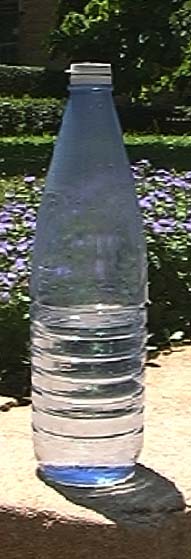 The following instructions are intended primarily for the benefit of
housewives in rural areas in developing countries where safe community
water supplies are not available. It is assumed that in these areas
water-borne diseases are endemic or sporadic.
The following instructions are intended primarily for the benefit of
housewives in rural areas in developing countries where safe community
water supplies are not available. It is assumed that in these areas
water-borne diseases are endemic or sporadic.
These instructions concern the procedure to be adopted on a routine
basis for the proper disinfection of drinking water for household use. The
procedure involves exposure to sunlight of water from the usual
community source for a minimum period of time in available transparent
containers such as colourless or blue-tinted glass or plastic bottles.
In order to save time and effort, it is highly desirable for a housewife
to make her own arrangements to carry out the routine disinfection
operation regularly once a day, or once every other day. For this reason,
a housewife should ensure enough containers that would hold the desired
quantity of drinking water estimated by her to meet the needs of the
family for one or two days.
At the end of the sunlight exposure period, a housewife could then
transfer indoors the whole set of containers for use. To avoid
recontamination, the already disinfected water should preferably be kept
in the same containers used in the solar exposure operation. However, if
there is a shortage of small containers, then the disinfected water could
be transferred from each exposed container to a clean large container
reserved for bulk storage of processed water.
Once a set of emptied containers becomes available after usage, the
refilling and exposure procedures are repeated. If the containers are
maintained in a good state of cleanliness, then there would be no reason
for having to clean them repeatedly each time they are to be re-used.
|
|
PROCEDURE
|
|
1. Containers:
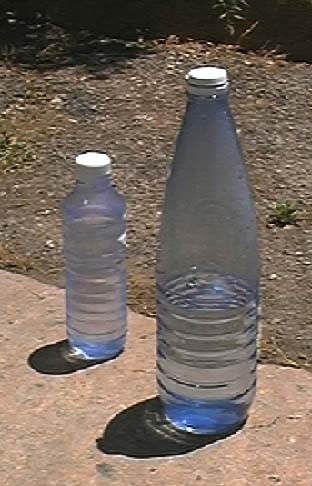
|
- From among those found at home, or purchased from the
local market, select a number of containers made of colourless or
blue-tinted glass or transparent plastic estimated to hold an amount
of drinking water sufficient for household consumption for one or two
days. The selected containers could include ordinary bottles, jars, or
any other types of vessels provided they are transparent to light.
Coloured containers other than blue, or greenish-blue should not be
used as they are not as satisfactory.
- Remove any detachable paper
labels from bottles, and wash all the containers with water (and soap,
if necessary) to remove dirt and any residue from the previous
contents.
|
|
2. Water:
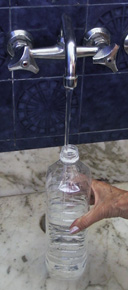
|
- Fetch water in the usual manner from the common
village supply (stream, well, pond, reservoir, etc.). If the water is
highly turbid, then clarify the water by allowing the suspended
particles to settle. Decant the clear water into other vessels.
- Carefully fill each of the containers hereafter
reserved for the solar disinfection operation with the clarified
water.
|
|
3. Exposure:
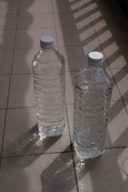
|
- Place the containers outdoors in an open space
where sunlight cannot be obstructed by houses, walls, trees, or bushes
throughout the day. Porches, balconies, roofs, or window sills would
be satisfactory if open land is not available. Select places away from
dust, children, domestic animals, and pets to avoid contamination
and mischief. Individual containers should be spread out to avoid
shadows.
- Keep the containers in their normal upright
position. Tilting them at an angle towards the sun (as is commonly
advocated for other solar appliances) may diminish the disinfection
efficiency. Stoppers for bottles, and original covers for jars may be
used to prevent the entry of dust, dirt, or vermin. But, such closures
are not essential for the disinfection process. In fact, water exposed
to bright sunlight in tightly closed containers could become much
warmer than that in open containers. This is because the water vapour
escaping from open containers carries with it some of the heat
acquired by the water exposed to sunlight.
- Since it is futile to maintain an exact time for
sunlight exposure, it would be a wise arrangement on a routine basis
to start the sunlight exposure operation at a convenient time in the
morning, and to keep the containers exposed until the late afternoon.
The exposed containers may then be kept in place overnight to allow
the water to cool, or they may be transferred indoors in readiness for
use. However, in such emergencies as when a family runs short of
disinfected drinking water, an exposure period of about two hours,
especially at noontime, should be adequate for proper disinfection.
These practical suggestions will ensure satisfactory results even
under moderately cloudy conditions. It would not be practical to carry
out the operation under conditions of heavy rainfall.
- After use, the empty containers can be re-used
without the need for rewashing unless they accidentally become dirty.
The cycle can now be repeated from the stage of refilling with water
through the stage of sunlight exposure. With time and experience,
the whole operation becomes a matter of routine. It should be noted
that these instructions need to be modified or simplified further by
health educators and primary health care promoters to suit local
conditions, provided the essential requirements are not altered in any
way.
|
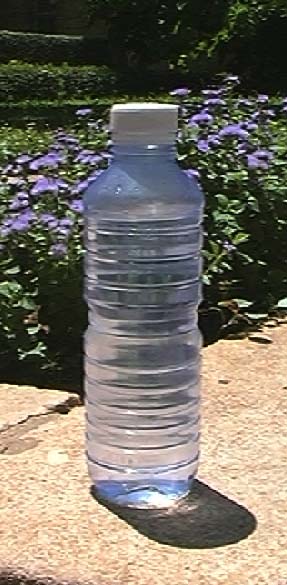 From: Aftim Acra, Zeina Raffoul and Yester Karahagopian
From: Aftim Acra, Zeina Raffoul and Yester Karahagopian
Solar Disinfection of Drinking Water and Oral Rehydration Solutions, page 50
Department of Environmental Health, Faculty of Health Sciences - American University of Beirut, UNICEF 1984
|
Digital Documentation Center - AUB - 970711/bl
Created by the Digital Documentation Center at AUB in collaboration with Al Mashriq of Høgskolen i Østfold,
Norway.
Email: ddc-info@aub.edu.lb
|

 The following instructions are intended primarily for the benefit of
housewives in rural areas in developing countries where safe community
water supplies are not available. It is assumed that in these areas
water-borne diseases are endemic or sporadic.
The following instructions are intended primarily for the benefit of
housewives in rural areas in developing countries where safe community
water supplies are not available. It is assumed that in these areas
water-borne diseases are endemic or sporadic.


 From: Aftim Acra, Zeina Raffoul and Yester Karahagopian
From: Aftim Acra, Zeina Raffoul and Yester Karahagopian